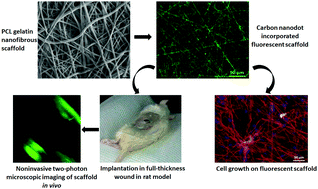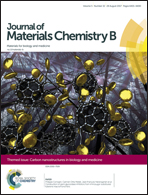Carbon nanodot impregnated fluorescent nanofibers for in vivo monitoring and accelerating full-thickness wound healing†
Abstract
Semiconductor quantum dots are overwhelmingly used for in situ monitoring and imaging of cell–scaffold interactions. However, quantum dots suffer from oxidative biodegradation in biological systems, besides being toxic due to the presence of heavy metals. In this study, we report the development of an intrinsically fluorescent nanofibrous scaffold of polycaprolactone–gelatin for skin tissue regeneration and noninvasive monitoring of scaffold activity in vivo. The presence of the incorporated carbon nanodots played a critical role in imparting the scaffold with these novel characteristics. The developed scaffold was uniform and bead free with fiber diameter of 698 ± 420 nm and pore diameter of 2.93 ± 1.13 μm. Inclusion of carbon nanodots not only bestowed uniform fluorescence of the scaffold but also promoted fibroblast cell adhesion, migration and proliferation. Co-culture of fibroblast and keratinocyte cells on the scaffold surface also enabled the development of a stratified epithelial layer. The scaffold exhibited antioxidant properties by scavenging free radicals and reducing the expression of antioxidative enzymes. Upon implantation in a full-thickness excision wound, the scaffold accelerated the progression of healing and the regenerated skin exhibited a stratified epithelial layer with mature dermal tissue. The scaffold enabled noninvasive monitoring of the wound healing kinetics in vivo through two-photon microscopy. With excellent photoluminescence, biocompatibility, and photo stability, the scaffold can suitably be used for prolonged monitoring of cell–scaffold interactions and further efficiently reduce the oxidative stress during continuous imaging. Additionally, being synthesized from inexpensive precursors employing a simple procedure, carbon nanodot production is cost-effective and the developed scaffold would be an off-the-shelf, readily available economical product.

- This article is part of the themed collection: Carbon Nanostructures in Biology and Medicine


 Please wait while we load your content...
Please wait while we load your content...